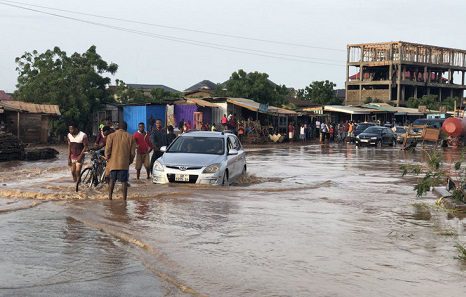Ghana has been grappling with devastating floods for nearly a century, a crisis that continues to claim lives, destroy homes, and cripple the economy.
Despite the repeated cycle of disasters, little has changed, with poor urban planning, weak enforcement of building regulations, illegal mining, and climate change all exacerbating the problem.
The recent directive by President John Dramani Mahama to demolish structures in flood-prone areas has reignited debates about Ghana’s preparedness and political will to address the crisis.
However, many question whether this will be an effective long-term solution or yet another temporary measure that fails to address the root causes of the problem. Mahama’s directive came after he inspected ongoing drainage system works in Accra on April 2, where he visited several sites, including the Abofu Achimota Bridge, Mallam Junction, and Odawna in Circle.
He emphasized the urgency of accelerating the Accra Academy main drain system to prevent flooding in areas like Kaneshie and Bubuashie.
“We are in April, and the rains are about starting. May-June is the climax of the rains in Accra. This Greater Accra Resilient and Integrated Development (GARID) project was given from last year. From what I have seen, this project is not going to begin before the rains open up. If that happens, we must expect that there will be severe flooding this season,” he cautioned.
The history of Ghana’s floods traces back as far as 1935, when Accra experienced its first major recorded flooding event, exposing the city’s vulnerability to heavy rainfall. By 1959, both Accra and Kumasi faced massive inundation, revealing the consequences of unchecked urban expansion and inadequate drainage systems.
Yet, no lasting solutions were implemented. Northern Ghana suffered some of the worst flooding disasters in the 1990s and 2000s, with the 1995 floods displacing over 100,000 people and the 2007 floods leaving more than 400,000 homeless.
The World Bank reported over 50 deaths from the latter disaster, emphasizing that the northern regions suffer the most from flooding yet receive the least attention in mitigation efforts. In 2010, Accra faced an urban flooding nightmare when heavy rains killed 35 people, with experts attributing the destruction to poor drainage and illegal construction.
However, nothing could have prepared the country for the June 3, 2015 disaster, when torrential rains combined with a petrol station explosion led to the deaths of over 150 people, causing economic losses exceeding $100 million. This tragedy was widely regarded as a man-made disaster, with experts warning that all the signs had been ignored.
In recent years, the pattern has continued, with major flooding events in 2017, 2020, and 2023 causing hundreds of deaths and displacing thousands. Each disaster follows a familiar script: heavy rains, clogged drains, submerged homes, and preventable deaths.
Beyond the loss of lives, the economic toll of flooding in Ghana is staggering. The World Bank estimates that the country loses between $100 million and $250 million annually due to flood damage, with agriculture suffering losses of up to $100 million per year. Infrastructure destruction costs an additional $30 million to $80 million annually, setting back national development efforts. Farmers lose entire harvests, roads collapse, and businesses shut down—floods continue to push Ghana backward every year.
The reasons behind Ghana’s flooding crisis are well-documented. Poor urban planning and illegal construction remain significant challenges, with only 40% of Accra covered by proper drainage systems. Rapid and unplanned urbanization has led to buildings being erected in waterways, worsening the impact of heavy rains.
Politicians, in an effort to secure votes, often allow these illegal constructions, only to order demolitions when disaster strikes. Illegal mining, commonly known as “galamsey,” has also played a major role in worsening floods, with siltation from mining activities clogging rivers and reducing water flow.
The White Volta and Pra River basins have been severely affected, making floods even deadlier. Climate change further exacerbates the problem, as data from the Intergovernmental Panel on Climate Change (IPCC) indicates that West Africa is experiencing increasingly erratic and intense rainfall patterns.
Ghana’s Meteorological Agency reports that Accra’s rainfall intensity has risen by 20% since 2000, signaling a worsening trend. Corruption and weak enforcement of regulations only deepen the crisis, with drainage projects often abandoned or poorly maintained and building permits issued in flood-prone zones due to bribery and political interference.
Government responses have often been reactive rather than preventive. The National Disaster Management Organization (NADMO) primarily focuses on emergency relief instead of long-term mitigation. The World Bank’s $200 million Greater Accra Resilient and Integrated Development (GARID) project aims to improve the city’s drainage systems but delays and mismanagement have raised concerns about its effectiveness.
The latest round of demolitions, following Mahama’s directive, reflects a history of short-term interventions that fail to address systemic issues. While removing illegal structures may help in some cases, experts argue that true flood resilience requires comprehensive upgrades to drainage infrastructure, strict zoning enforcement, and affordable housing solutions to prevent encroachment on flood-prone areas.
If no drastic action is taken, the consequences could be dire. The UN Development Programme (UNDP) projects that Ghana’s annual losses from floods could exceed $500 million by 2030. Accra and Kumasi remain high-risk zones, with urban expansion continuing unchecked.
However, solutions exist, and experts have outlined clear strategies for flood prevention. These include strict enforcement of building laws, massive investments in drainage infrastructure, a crackdown on illegal mining activities, and climate-resilient urban planning. The knowledge and blueprints to address the crisis are available, but real commitment beyond election cycles remains elusive.
Ghana’s flooding crisis is largely a man-made disaster, worsened by negligence, corruption, and climate change. Demolishing illegal structures may be a necessary step, but without systemic reforms, floods will continue to wreak havoc on the country. The ultimate question remains: Will Ghana finally learn from history and take decisive action, or will the next flood disaster bring yet another round of empty promises?













